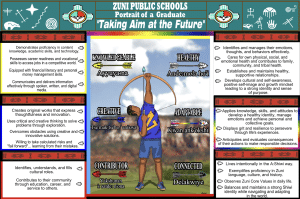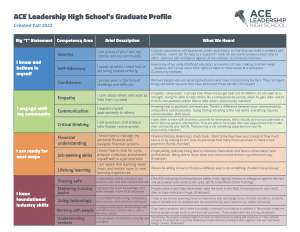Innovation in New Mexico: Defining Local Visions of Graduate Success
CompetencyWorks Blog
This is the second in a series of posts about statewide innovation in New Mexico.
When working to build a competency-based education system, creating a profile of a graduate is a common starting place. Graduate profiles define a shared vision for learner outcomes where rigorous, common expectations for learning (knowledge, skills, and dispositions) are explicit, transparent, measurable, and transferable.
At its simplest, a graduate profile is a written or illustrated document that defines goals and “the cognitive, personal and interpersonal competencies that students should have when they graduate,” according to language from the New Mexico legislature. At their best, these documents serve as strong anchors to drive other changes towards a broader shift to a student-centered, competency-based system.
In New Mexico, graduate profiles are specific to each district or individual charter school, so they are inherently a unique document of what success looks like in a local context. Here are three examples:
Zuni Public School District
The first tribally controlled public school system in the United States, Zuni Public School District includes an elementary, middle, high, and alternative school. It’s located on the far western edge of the state, inside the Zuni Pueblo and surrounded by other pueblos and reservations. Zuni’s isolation, large population, geographic size, and deep history have resulted in a unique language and culture.
The district’s graduate profile is illustrated by a graphic of a Zuni student with a bow and arrow taking aim at their future. The graphic is bilingual in English and the Zuni language. An expanded version includes text that explains each core quality of a successful graduate.
A Zuni representative went to the first EdUprising conference in 2020 and joined the Future Focused Education-facilitated Innovative Assessment Community of Practice that launched the same year. Participation in both of these supported the Zuni community in developing their graduate profile process, in which Zuni school and district leaders organized 20 focus groups and conducted a survey with over 500 respondents. Emphasis on the Zuni language and culture emerged as a key theme, which aligns with the district’s origins in 1980. The graduate profile drives all efforts and reinforces the promise to integrate Zuni language and culture into the education system.
Since the creation of the profile, Zuni High School has been working to integrate the profile elements. An early step was to add a capstone project, which emphasizes the Zuni language, as a culminating demonstration of graduate readiness (more on capstone projects in the next post in this series). Another key change is the inclusion of a Zuni language and culture competency in every class in addition to existing academic outcomes. In 2022, they began to pilot a shift to competency-based learning and assessment in all classes.
ACE Leadership High School
Another early adopter, Albuquerque public charter school ACE (Architecture, Construction, Engineering) Leadership High School, completed their graduate profile in January 2022. The ACE team created multiple illustrations to demonstrate their graduate profile, the second of which goes into more detail about results of their community conversations. The profile has an accompanying industry framework informed by focus groups and interviews with industry professionals and postsecondary faculty. The competency definitions in the profile provide a roadmap for ACE students, families, teachers, staff, and industry partners in learning through industry-relevant projects and other student experiences (I’ll explore the school’s industry connections and work-based learning in two future posts).
 ACE Executive Director Justin Trager reflected that “One of the biggest takeaways is that it is a lot easier to write a graduate profile and make nice posters than to implement it with fidelity.” When they first finished it, they rolled it out with the full staff and made an assets and opportunity map. Building on their self-assessment, they ended the session by “asking each staff member to do one thing that would help us implement it. It is important to share the responsibility.” ACE’s profile reflects their foundational focus on teaching industry skills and their strong commitment to social-emotional learning and supporting students’ post secondary transition.
ACE Executive Director Justin Trager reflected that “One of the biggest takeaways is that it is a lot easier to write a graduate profile and make nice posters than to implement it with fidelity.” When they first finished it, they rolled it out with the full staff and made an assets and opportunity map. Building on their self-assessment, they ended the session by “asking each staff member to do one thing that would help us implement it. It is important to share the responsibility.” ACE’s profile reflects their foundational focus on teaching industry skills and their strong commitment to social-emotional learning and supporting students’ post secondary transition.

Robert F. Kennedy Charter School
RFK Charter School started their Innovation Zone work by tapping the community to create a Profile of a Graduate. The process involved focus groups with parents, teachers, and community members and input from a student design team. After the charter’s board approved the final language, the school ran a contest for the profile design. The student design team continues to be involved in setting benchmarks at different grade levels to define expectations for demonstrating the profile elements.
 Future Focused Education has written about two other New Mexico examples: Peñasco School District and Lake Arthur Municipal Schools. Future Focused, through the Community of Practice, developed a Graduate Profile process that many districts are using:
Future Focused Education has written about two other New Mexico examples: Peñasco School District and Lake Arthur Municipal Schools. Future Focused, through the Community of Practice, developed a Graduate Profile process that many districts are using:
- See the System through a Graduation Assessment
- Determining your “Why”
- Community Engagement
- Data Analysis
- Design
- Using your Graduate Profile
Following the lead of these schools and districts, 2024 New Mexico legislation recently updated the state’s high school graduation requirements and now requires all charter and traditional schools to include graduate profiles. The move shows that Innovation Zone prototypes can inform changes across the state’s education system.
At the close of the 2023-2024 school year, Future Focused estimates that approximately 75% of the Innovation Schools have created a graduate profile or are almost through the process. With a graduate profile in hand, schools and school systems can organize practices around more than just passing tests or learning academic standards. For example:
- How are skills incorporated into the day-to-day learning and classroom experiences (e.g., curriculum)?
- How will schools measure progress on these core competencies (e.g., assessment)?
When schools continually revisit the graduate profile to ensure they remain aligned to the shared vision, they gain momentum in making other important shifts – such as in instructional practice and school culture – to meet student and community needs.
Learn More
- Portrait of a Graduate: A Gateway to Competency-Based Learning
- More States Are Creating a ‘Portrait of a Graduate.’ Here’s Why
- Profile of a Graduate to Redefine Student Success for the Future

Laurie Gagnon is the CompetencyWorks Program Director at the Aurora Institute. She leads the work of sharing promising practices shaping the future of K-12 personalized, competency-based education (CBE). Laurie lives in Somerville, MA with her partner, young son, and cat.